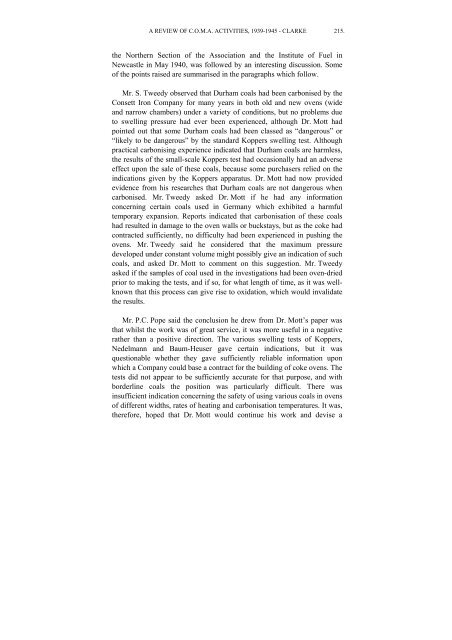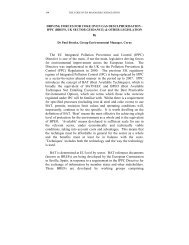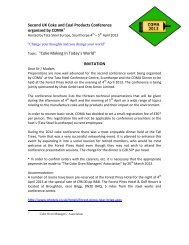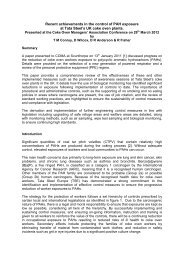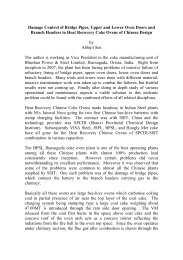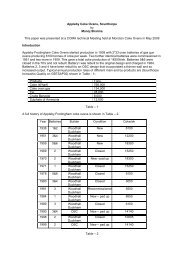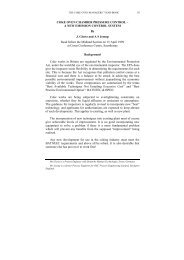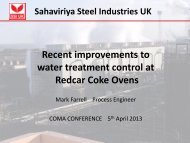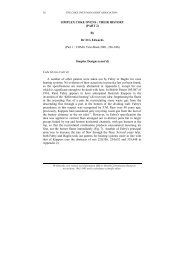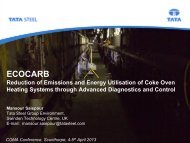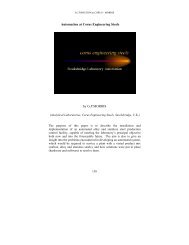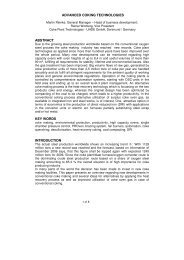CHAIRMAN'S ADDRESS - Coke Oven Managers Association
CHAIRMAN'S ADDRESS - Coke Oven Managers Association
CHAIRMAN'S ADDRESS - Coke Oven Managers Association
- No tags were found...
Create successful ePaper yourself
Turn your PDF publications into a flip-book with our unique Google optimized e-Paper software.
A REVIEW OF C.O.M.A. ACTIVITIES, 1939-1945 - CLARKE 215.the Northern Section of the <strong>Association</strong> and the Institute of Fuel inNewcastle in May 1940, was followed by an interesting discussion. Someof the points raised are summarised in the paragraphs which follow.Mr. S. Tweedy observed that Durham coals had been carbonised by theConsett Iron Company for many years in both old and new ovens (wideand narrow chambers) under a variety of conditions, but no problems dueto swelling pressure had ever been experienced, although Dr. Mott hadpointed out that some Durham coals had been classed as “dangerous” or“likely to be dangerous” by the standard Koppers swelling test. Althoughpractical carbonising experience indicated that Durham coals are harmless,the results of the small-scale Koppers test had occasionally had an adverseeffect upon the sale of these coals, because some purchasers relied on theindications given by the Koppers apparatus. Dr. Mott had now providedevidence from his researches that Durham coals are not dangerous whencarbonised. Mr. Tweedy asked Dr. Mott if he had any informationconcerning certain coals used in Germany which exhibited a harmfultemporary expansion. Reports indicated that carbonisation of these coalshad resulted in damage to the oven walls or buckstays, but as the coke hadcontracted sufficiently, no difficulty had been experienced in pushing theovens. Mr. Tweedy said he considered that the maximum pressuredeveloped under constant volume might possibly give an indication of suchcoals, and asked Dr. Mott to comment on this suggestion. Mr. Tweedyasked if the samples of coal used in the investigations had been oven-driedprior to making the tests, and if so, for what length of time, as it was wellknownthat this process can give rise to oxidation, which would invalidatethe results.Mr. P.C. Pope said the conclusion he drew from Dr. Mott’s paper wasthat whilst the work was of great service, it was more useful in a negativerather than a positive direction. The various swelling tests of Koppers,Nedelmann and Baum-Heuser gave certain indications, but it wasquestionable whether they gave sufficiently reliable information uponwhich a Company could base a contract for the building of coke ovens. Thetests did not appear to be sufficiently accurate for that purpose, and withborderline coals the position was particularly difficult. There wasinsufficient indication concerning the safety of using various coals in ovensof different widths, rates of heating and carbonisation temperatures. It was,therefore, hoped that Dr. Mott would continue his work and devise a


